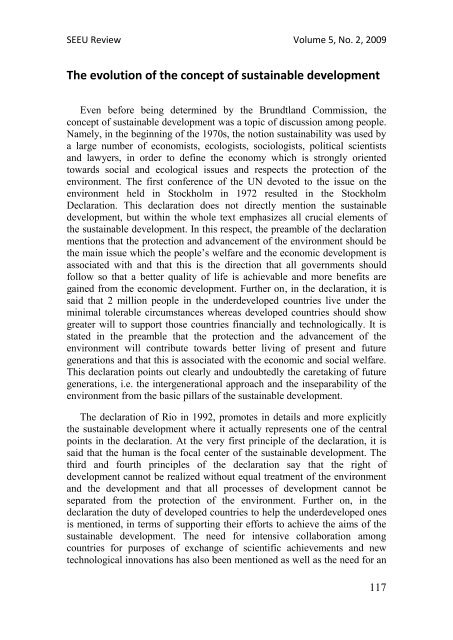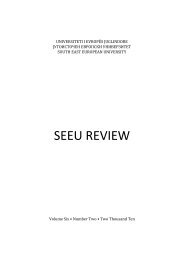SEEU Review vol. 5 Nr. 2 (pdf) - South East European University
SEEU Review vol. 5 Nr. 2 (pdf) - South East European University
SEEU Review vol. 5 Nr. 2 (pdf) - South East European University
You also want an ePaper? Increase the reach of your titles
YUMPU automatically turns print PDFs into web optimized ePapers that Google loves.
<strong>SEEU</strong> <strong>Review</strong> Volume 5, No. 2, 2009<br />
The e<strong>vol</strong>ution of the concept of sustainable development<br />
Even before being determined by the Brundtland Commission, the<br />
concept of sustainable development was a topic of discussion among people.<br />
Namely, in the beginning of the 1970s, the notion sustainability was used by<br />
a large number of economists, ecologists, sociologists, political scientists<br />
and lawyers, in order to define the economy which is strongly oriented<br />
towards social and ecological issues and respects the protection of the<br />
environment. The first conference of the UN devoted to the issue on the<br />
environment held in Stockholm in 1972 resulted in the Stockholm<br />
Declaration. This declaration does not directly mention the sustainable<br />
development, but within the whole text emphasizes all crucial elements of<br />
the sustainable development. In this respect, the preamble of the declaration<br />
mentions that the protection and advancement of the environment should be<br />
the main issue which the people’s welfare and the economic development is<br />
associated with and that this is the direction that all governments should<br />
follow so that a better quality of life is achievable and more benefits are<br />
gained from the economic development. Further on, in the declaration, it is<br />
said that 2 million people in the underdeveloped countries live under the<br />
minimal tolerable circumstances whereas developed countries should show<br />
greater will to support those countries financially and technologically. It is<br />
stated in the preamble that the protection and the advancement of the<br />
environment will contribute towards better living of present and future<br />
generations and that this is associated with the economic and social welfare.<br />
This declaration points out clearly and undoubtedly the caretaking of future<br />
generations, i.e. the intergenerational approach and the inseparability of the<br />
environment from the basic pillars of the sustainable development.<br />
The declaration of Rio in 1992, promotes in details and more explicitly<br />
the sustainable development where it actually represents one of the central<br />
points in the declaration. At the very first principle of the declaration, it is<br />
said that the human is the focal center of the sustainable development. The<br />
third and fourth principles of the declaration say that the right of<br />
development cannot be realized without equal treatment of the environment<br />
and the development and that all processes of development cannot be<br />
separated from the protection of the environment. Further on, in the<br />
declaration the duty of developed countries to help the underdeveloped ones<br />
is mentioned, in terms of supporting their efforts to achieve the aims of the<br />
sustainable development. The need for intensive collaboration among<br />
countries for purposes of exchange of scientific achievements and new<br />
technological innovations has also been mentioned as well as the need for an<br />
117

















